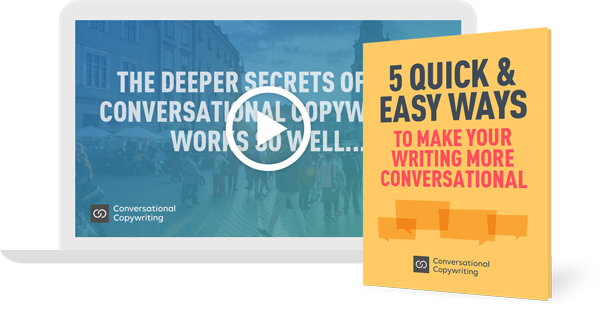At school we are taught to write properly. Our work is marked and graded. Grammar matters. And so on.
But when we talk with our friends, we don’t worry about that stuff.
We’ll talk in fragments of sentences. We’ll start sentences with the word “and”. We’ll end sentences with prepositions.
We don’t worry about the structure of our sentences or paragraphs. Not that we really speak in paragraphs.
The point being, when we communicate through writing, everything is more formal, more structured, more correct.
When we communicate by talking, in everyday conversation, we sound more natural.
In the world of marketing, a natural, conversational style is more likely to help us connect with our readers at an emotional level. And it allows us to be persuasive without sounding like a salesperson.
So yes, if you want to learn the craft of conversational copywriting, part of the process is to start writing in a way that sounds more like spoken language.
BUT… it’s not quite that simple.
In spoken language, if you record it and listen carefully, or transcribe it, you’ll find we tend to be really messy and disorganized. We repeat ourselves. We meander and digress. Go off in weird directions, and then double back.
So in that sense, spoken language isn’t perhaps a perfect match for what we want to achieve in conversational copywriting.
Too much meandering.
So what’s the answer?
It lies somewhere in between written and spoken language.
The answer lies in the dialog we see between characters in our favorite novels, movies and TV shows.
What fiction writers do is create dialog that sounds natural, but is actually very carefully crafted… without the constant repetitions, distractions and diversions of everyday conversation.
So if you want a model for conversational copywriting, one of your best sources for learning the craft is by studying the dialog written by novelists and screenplay writers.
You get all the emotional punch you’re looking for, but in a more structured and abbreviated form.
Who would have thought?
Copywriters rarely think about fiction writers as sources of inspiration or learning. But it absolutely makes sense of you want to be a conversational copywriter.
NOTE: If you’d like to add the craft of conversational copywriting to your online writer’s toolbox, find out about the Conversational Copywriting course here…
What people are saying…
“I can definitely see how all the usual cliches and sales patter of traditional marketing is getting overlooked now, and that conversational copy is the way to go. Fab course Nick, thanks!” Katie Sayce
“By nature, I’m not the pushy, hype-y, manipulative salesperson type. That is what turns me off from doing any type of sales work. I like the genuine, honest and friendship forming kind of two-way copywriting that conversational copywriting conveys. In my opinion, conversational copywriting is more appealing to the younger generations of consumers coming up in today’s marketplace.” Sheila Koester
Learn more about the Conversational Copywriting course here…
